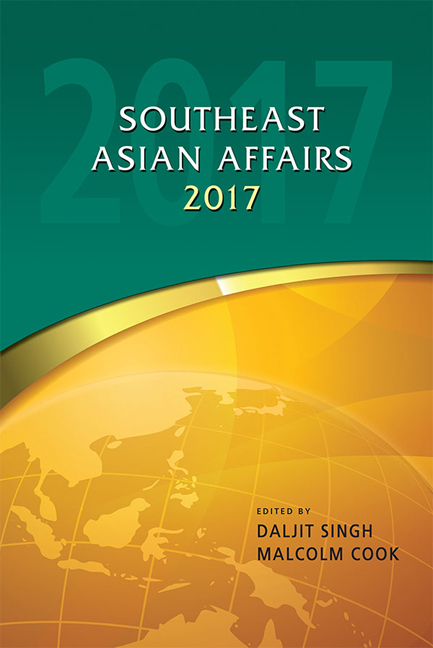Book contents
- Frontmatter
- Contents
- Foreword
- Introduction
- Acknowledgements
- THE REGION
- BRUNEI DARRUSALAM
- CAMBODIA
- INDONESIA
- LAOS
- MALAYSIA
- Malaysia in 2016: Persistent Crises, Rapid Response, and Resilience
- Realignment of State–Centre Relations: The Adenan Factor in Sarawak
- MYANMAR
- THE PHILIPPINES
- SINGAPORE
- THAILAND
- TIMOR-LESTE
- VIETNAM
Realignment of State–Centre Relations: The Adenan Factor in Sarawak
from MALAYSIA
Published online by Cambridge University Press: 12 January 2018
- Frontmatter
- Contents
- Foreword
- Introduction
- Acknowledgements
- THE REGION
- BRUNEI DARRUSALAM
- CAMBODIA
- INDONESIA
- LAOS
- MALAYSIA
- Malaysia in 2016: Persistent Crises, Rapid Response, and Resilience
- Realignment of State–Centre Relations: The Adenan Factor in Sarawak
- MYANMAR
- THE PHILIPPINES
- SINGAPORE
- THAILAND
- TIMOR-LESTE
- VIETNAM
Summary
The Chief Minister has said time and again that Sarawak will never secede from Malaysia but that doesn't mean the State cannot fight for its rights as enshrined in the Federal Constitution, The Malaysia Agreement 1963, The Malaysia Act, The Inter-Government Committee Reports and Recommendations and the Cobbold Commission Reports. (Press Statement from Chief Minister's Office, 7 November 2016)
The statement above issued by the Chief Minister's office partly explains why Sarawak's politics took a slightly different trajectory after Adenan Satem took over as the new Chief Minister for Sarawak from Taib Mahmud on 28 February 2014. He argues in his speeches that Sarawak had been left behind and needs to catch up with other states in the Federation of Malaysia. In Sarawak's local dialect, Adenan Satem used the word “ngepong”, referring to catching up with other states. His catching-up strategies are central to the current centre–state relations in Sarawak. This chapter discusses centre–state relations between Putra Jaya and Kuching, specifically after Adenan Satem took over from Taib Mahmud. Responses from the centre to this political realignment are also discussed.
Federalism in Malaysia
A federal system divides power between the national government and the smaller local governments. The advantage of a federal government is that it helps to address the needs of a geographically large country. The needs at the local level of each state differ, and they should have different local governments to address those needs. In theory, federalism assumes that there exist diverse and separate communities who want to unite but which are at the same time eager to maintain a separate existence.1 More often than not, centre–state relations in a federation are quite fluid. However, they should be stable if local leaders support the concentration of power at the centre as a means to safeguard the integrity of the country. In cases where states are controlled by a different political party, relations between the centre and state might be quite fluid.
The Federation of Malaysia was established in 1963 by an agreement between the governments of Malaya, the United Kingdom, and the leaders of the people of Sarawak, Sabah (North Borneo), and Singapore, through the 1963 Malaysian Agreement signed on 8 July 1963. Sarawak has a population of almost 2.5 million, made up of some twenty-six ethnic groups.
- Type
- Chapter
- Information
- Southeast Asian Affairs 2017 , pp. 221 - 234Publisher: ISEAS–Yusof Ishak InstitutePrint publication year: 2017

